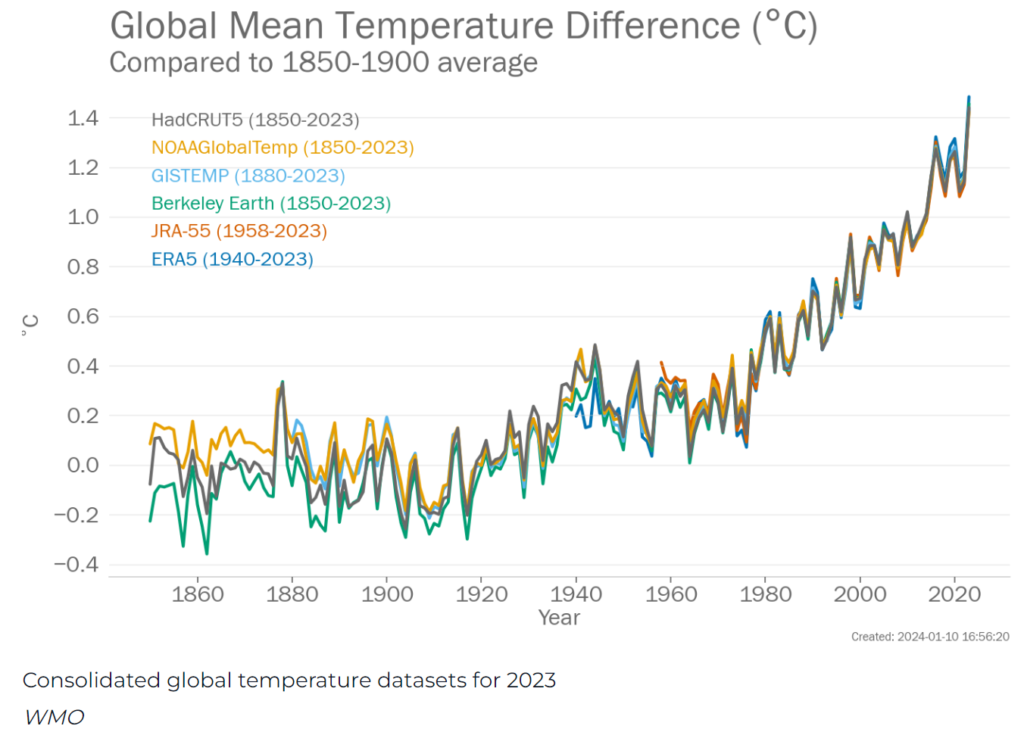Good News. Bad News.
You’ve surely heard the phrase, “I have good news and bad news, which would you like first?” Growing up I always learned to get the bad out of the way first so as 2024 begins I have good news and bad news for you and, true to form, will start with the bad.
Bad News
As I have been predicting through much of last year, 2023 has now officially been anointed as the hottest year on record since global temperature records have been kept. It produced both the hottest summer on record in the Northern Hemisphere and the warmest winter on record in the Southern Hemisphere.
Simply leaving your home meant it was impossible to see a dramatic change in the weather and our climate. 25 disasters that struck the United States each caused over $1 billion in damage… a record. South California suffered its first tropical storm warning (in August) while Canadian wildfires turned New York City skies dark orange and sounded air quality alarms all over the East Coast as deadly tornadoes and devastating floods tortured the Midwest. And the weather-oriented disasters were not, of course, just limited to the United States. Tropical Cyclone Freddy was the longest cyclone in history and caused devastating flooding and landslides in many regions of Madagascar and Mozambique.
But nearly everywhere you went or lived last year the story was the heat. 2023’s global mean temperature was 1.48 degrees Celsius above the pre-industrial average, a figure perilously close to the 1.5 degree aspirational goal in 2015 during the United Nation’s COP21, in what is known as the Paris Agreement. In 2023 mankind produced the hottest June ever recorded. Then the hottest July, followed by the hottest August, the hottest September, the hottest October, the hottest November, and, sadly, also the hottest December. Seven straight months that each broke heat records as compared to the entire recorded history of such records.
In fact, every single day in 2023 was at least 1 degree Celsius above the pre-industrial times (1850 to 1900) when fossil fuels became prevalent and have since lead to causing our climate to heat and heat. Worse yet (yes, the bad news seems to keep getting worse and will until we eliminate fossil fuels) is that two days, November 17th and 18th, were the first to measure 2 degrees Celsius above pre-industrial levels. Keeping temperatures within 1.5 degrees of pre-industrial levels is critical to mankind avoiding the worst impacts of our climate crisis but an increase that’s 2 degrees or higher will have simply devastating impacts all over earth.
Here’s how the World Meteorological Organization (WMO) and a host of other scientific agencies all over the world documented the record setting temperature, records that shattered historic results by, as the WMO said, a “huge margin.”
NASA, NOAA, and a host of other climate experts are predicting that 2024 could very well break last year’s record and, for that matter, break through the 1.5 degree level. So, yeah, “Happy” New Year with that prediction. It’s time every one of us get serious about eliminating mankind’s use of fossil fuels before it’s truly too late.
Good News
As the new year starts all of the news, thankfully, is not bad. In fact, we start the new year with some incredibly great climate-oriented news here the United States. You see, 2023 saw the United States decrease (yes, you read that right, decrease) our fossil fuel pollution emissions by 1.9%, the largest decline since COVID19 led folks to stay inside, stop driving, working or traveling (and a time emissions declined an estimated 2.4%). Here’s a chart from the Rhodium Group that illustrates the correlation of results between economic growth (or decline) in recent years and green house gas emissions increase or decrease each year:
So, how did we actually reduce polluting emissions, much less do it in a year when the United States economy grew (+2.4%) robustly? Simply stated, coal use in the United States declined again last year and carbon emissions from coal, in turn, fell by 8%. And the warmer winter mentioned above led to emissions from things like natural gas, fuel, oil, and propane used to heat buildings to fall and polluting emissions from those fossil fuels fell by 4%.
Coal use continues to decline and that’s good news. In 2023 it’s estimated that just 17% of energy generated in the United States was derived from coal, the lowest such figure since 1969. Nuclear power, conversely, for the second year in a row moved ahead of coal as an American energy source.
Now, the news (sorry) here is not all good or great. Travel continuing to rebound meant that transportation emissions from airplanes increased 1.6%. Industrial emissions increased 1.2% as a result of an increase in oil and gas production.
While news of 2023’s record breaking temperatures should alarm all of us, the progress we are making by shifting away from coal shows that if mankind can muster the fortitude to eliminate fossil fuel use and shift to sustainable energy quickly we can, just maybe, avoid the worst impacts of our climate change crisis. But there’s not a day to wait.
For the United States to lead the world (as we should) towards fixing our climate crisis we need to reduce our polluting carbon emissions by at least 50% by 2030, a goal that means we must triple our emission reductions each year over the next six years so there’s no time to waste.
Not even one day.
Happy 2024 everyone. Here’s to hoping it’s a wonderful year for you and your loved ones that is filled with great health and happiness.

